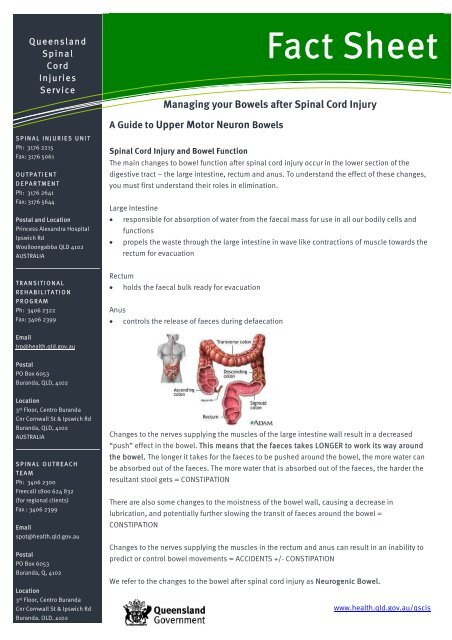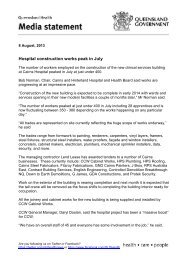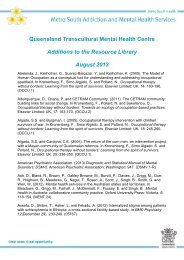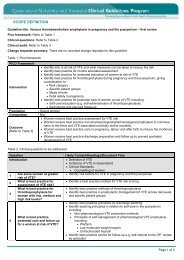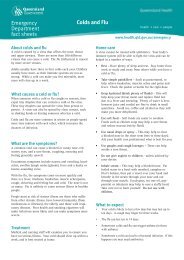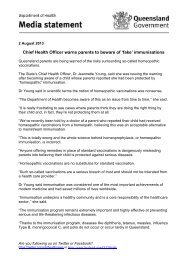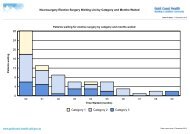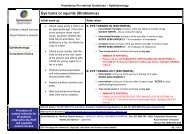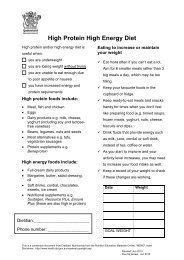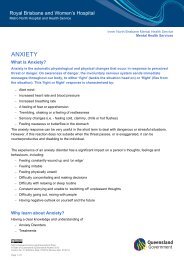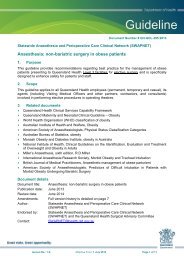A Guide to Upper Motor Neuron Bowels - Queensland Health
A Guide to Upper Motor Neuron Bowels - Queensland Health
A Guide to Upper Motor Neuron Bowels - Queensland Health
Create successful ePaper yourself
Turn your PDF publications into a flip-book with our unique Google optimized e-Paper software.
<strong>Queensland</strong><br />
Spinal<br />
Cord<br />
Injuries<br />
Service<br />
Fact Sheet<br />
Managing your <strong>Bowels</strong> after Spinal Cord Injury<br />
A <strong>Guide</strong> <strong>to</strong> <strong>Upper</strong> Mo<strong>to</strong>r <strong>Neuron</strong> <strong>Bowels</strong><br />
SPINAL INJURIES UNIT<br />
Ph: 3176 2215<br />
Fax: 3176 5061<br />
OUTPATIENT<br />
DEPARTMENT<br />
Ph: 3176 2641<br />
Fax: 3176 5644<br />
Postal and Location<br />
Princess Alexandra Hospital<br />
Ipswich Rd<br />
Woolloongabba QLD 4102<br />
AUSTRALIA<br />
Spinal Cord Injury and Bowel Function<br />
The main changes <strong>to</strong> bowel function after spinal cord injury occur in the lower section of the<br />
digestive tract – the large intestine, rectum and anus. To understand the effect of these changes,<br />
you must first understand their roles in elimination.<br />
Large Intestine<br />
• responsible for absorption of water from the faecal mass for use in all our bodily cells and<br />
functions<br />
• propels the waste through the large intestine in wave like contractions of muscle <strong>to</strong>wards the<br />
rectum for evacuation<br />
TRANSITIONAL<br />
REHABILITATION<br />
PROGRAM<br />
Ph: 3406 2322<br />
Fax: 3406 2399<br />
Rectum<br />
• holds the faecal bulk ready for evacuation<br />
Anus<br />
• controls the release of faeces during defaecation<br />
Email<br />
trp@health.qld.gov.au<br />
Postal<br />
PO Box 6053<br />
Buranda, QLD, 4102<br />
Location<br />
3 rd Floor, Centro Buranda<br />
Cnr Cornwall St & Ipswich Rd<br />
Buranda, QLD, 4102<br />
AUSTRALIA<br />
SPINAL OUTREACH<br />
TEAM<br />
Ph: 3406 2300<br />
Freecall 1800 624 832<br />
(for regional clients)<br />
Fax : 3406 2399<br />
Email<br />
spot@health.qld.gov.au<br />
Postal<br />
PO Box 6053<br />
Buranda, Q, 4102<br />
Location<br />
3 rd Floor, Centro Buranda<br />
Cnr Cornwall St & Ipswich Rd<br />
Buranda, QLD, 4102<br />
Changes <strong>to</strong> the nerves supplying the muscles of the large intestine wall result in a decreased<br />
“push” effect in the bowel. This means that the faeces takes LONGER <strong>to</strong> work its way around<br />
the bowel. The longer it takes for the faeces <strong>to</strong> be pushed around the bowel, the more water can<br />
be absorbed out of the faeces. The more water that is absorbed out of the faeces, the harder the<br />
resultant s<strong>to</strong>ol gets = CONSTIPATION<br />
There are also some changes <strong>to</strong> the moistness of the bowel wall, causing a decrease in<br />
lubrication, and potentially further slowing the transit of faeces around the bowel =<br />
CONSTIPATION<br />
Changes <strong>to</strong> the nerves supplying the muscles in the rectum and anus can result in an inability <strong>to</strong><br />
predict or control bowel movements = ACCIDENTS +/- CONSTIPATION<br />
We refer <strong>to</strong> the changes <strong>to</strong> the bowel after spinal cord injury as Neurogenic Bowel.<br />
www.health.qld.gov.au/qscis
<strong>Queensland</strong><br />
Spinal<br />
Cord<br />
Injuries<br />
Service<br />
Fact Sheet<br />
SPINAL INJURIES UNIT<br />
Ph: 3176 2215<br />
Fax: 3176 5061<br />
OUTPATIENT<br />
DEPARTMENT<br />
Ph: 3176 2641<br />
Fax: 3716 5644<br />
Postal and Location<br />
Princess Alexandra Hospital<br />
Ipswich Rd<br />
Woolloongabba QLD 4102<br />
AUSTRALIA<br />
TRANSITIONAL<br />
REHABILITATION<br />
PROGRAM<br />
Ph: 3406 2322<br />
Fax: 3406 2399<br />
Email<br />
trp@health.qld.gov.au<br />
Postal<br />
PO Box 6053<br />
Buranda, QLD, 4102<br />
Location<br />
3 rd Floor, Centro Buranda<br />
Cnr Cornwall St & Ipswich Rd<br />
Buranda, QLD, 4102<br />
AUSTRALIA<br />
SPINAL OUTREACH<br />
TEAM<br />
Ph: 3406 2300<br />
Freecall 1800 624 832<br />
(for regional clients)<br />
Fax : 3406 2399<br />
Email<br />
spot@health.qld.gov.au<br />
How Do I Manage a Neurogenic Bowel?<br />
To be able <strong>to</strong> manage these changes effectively, you must understand what TYPE of bowel you<br />
have after your injury. There are two main types of Neurogenic Bowel, which are determined by<br />
your level of injury, and the potential interruption of processing of messages through the<br />
Defaecation Reflex Centre.<br />
The Defaecation Reflex Centre controls the muscles and feeling <strong>to</strong> the lower colon, rectum and<br />
anus, and works in conjunction with the brain <strong>to</strong> determine when <strong>to</strong> “hold” or “go”. When mass is<br />
detected in the rectum, the reflex initiates a strong contraction of these muscles, assisting in<br />
defaecation. The disruption of this reflex can result in either:<br />
1. <strong>Upper</strong> Mo<strong>to</strong>r <strong>Neuron</strong> (Reflexive) Bowel<br />
2. Lower Mo<strong>to</strong>r <strong>Neuron</strong> (Flaccid) Bowel<br />
The management for each of these bowel types differs significantly. This booklet specifically<br />
targets the management of <strong>Upper</strong> Mo<strong>to</strong>r <strong>Neuron</strong> bowels. If you are unsure of your bowel type,<br />
please talk <strong>to</strong> your Spinal Injuries Consultant, Outpatient Service, or the Spinal Outreach Team<br />
(SPOT) for further advice.<br />
What is an <strong>Upper</strong> Mo<strong>to</strong>r <strong>Neuron</strong> (UMN) bowel?<br />
<strong>Upper</strong> Mo<strong>to</strong>r <strong>Neuron</strong> bowel types most commonly occur in people with spinal cord injuries above<br />
the T12/L1 level. The presentation of this type of bowel is influenced by the intact action of the<br />
Defaecation Reflex centre, which causes an involuntary spasm- like contraction of the muscles of<br />
the rectum and anus.<br />
However, due <strong>to</strong> disruptions in the message pathways up and down the spinal cord due <strong>to</strong> spinal<br />
cord injury, people with UMN spinal injuries generally are unable <strong>to</strong> control the relaxing of this<br />
muscle <strong>to</strong> allow or prevent defaecation. They also may have difficulty determining whether their<br />
bowel is full, has already evacuated, or whether wind or solid matter has been passed.<br />
Why Do I Have <strong>to</strong> Change the Way I Manage My Bowel?<br />
Left untreated, people with UMN bowels will likely experience symp<strong>to</strong>ms such as chronic<br />
constipation and recurring bowel accidents. This can then further impact on many other facets of<br />
your health, work and social life, as well as personal relationships.<br />
Good Bowel Routines = More Effective and Predictable Emptying = Social Continence<br />
Postal<br />
PO Box 6053<br />
Buranda, Q, 4102<br />
Location<br />
3 rd Floor, Centro Buranda<br />
Cnr Cornwall St & Ipswich Rd<br />
Buranda, QLD, 4102<br />
www.health.qld.gov.au/qscis
<strong>Queensland</strong><br />
Spinal<br />
Cord<br />
Injuries<br />
Service<br />
Fact Sheet<br />
SPINAL INJURIES UNIT<br />
Ph: 3176 2215<br />
Fax: 3176 5061<br />
OUTPATIENT<br />
DEPARTMENT<br />
Ph: 3176 2641<br />
Fax: 3716 5644<br />
Postal and Location<br />
Princess Alexandra Hospital<br />
Ipswich Rd<br />
Woolloongabba QLD 4102<br />
AUSTRALIA<br />
TRANSITIONAL<br />
REHABILITATION<br />
PROGRAM<br />
Ph: 3406 2322<br />
Fax: 3406 2399<br />
Email<br />
trp@health.qld.gov.au<br />
Postal<br />
PO Box 6053<br />
Buranda, QLD, 4102<br />
Location<br />
3 rd Floor, Centro Buranda<br />
Cnr Cornwall St & Ipswich Rd<br />
Buranda, QLD, 4102<br />
AUSTRALIA<br />
The 5 “Rights” of Bowel Management<br />
Due <strong>to</strong> the complexity of the many different issues affecting bowel function after spinal cord<br />
injury, it is not possible <strong>to</strong> fix the problems simply by taking a tablet.<br />
To make it easier <strong>to</strong> understand, UMN bowel management has been broken in <strong>to</strong> 5 categories that<br />
need <strong>to</strong> be working well <strong>to</strong>gether <strong>to</strong> put you back on the “Right” path!<br />
Time<br />
Place<br />
Amount<br />
Consistency<br />
Trigger<br />
Right Time<br />
This refers <strong>to</strong> the need <strong>to</strong> re-establish a routine for bowel emptying post spinal cord injury. The<br />
bowel needs <strong>to</strong> be “re-trained” <strong>to</strong> empty at a regular and consistent time each day, which will<br />
allow you some predictability around when your bowels may open. You need <strong>to</strong> be in control of<br />
your bowels <strong>to</strong> prevent your bowels controlling your life!<br />
Firstly, you will need <strong>to</strong> establish how often you attend your bowel routine. We<br />
recommend either daily or second daily, depending on your pre-existing bowel<br />
habit. We do not recommend attending your bowel care any less than 3 times per week.<br />
Some fac<strong>to</strong>rs <strong>to</strong> consider when choosing a time:<br />
• Work hours<br />
• Any previous bowel habit prior <strong>to</strong> injury<br />
• Availability of <strong>to</strong>ileting facilities and care support<br />
The other aspect of the ‘right time’ is how much time should be spent on the routine. An average<br />
amount of time can be from 15-45 minutes, which depends on the s<strong>to</strong>ol being in the “Right Place”.<br />
SPINAL OUTREACH<br />
TEAM<br />
Ph: 3406 2300<br />
Freecall 1800 624 832<br />
(for regional clients)<br />
Fax : 3406 2399<br />
Email<br />
spot@health.qld.gov.au<br />
Postal<br />
PO Box 6053<br />
Buranda, Q, 4102<br />
Location<br />
3 rd Floor, Centro Buranda<br />
Cnr Cornwall St & Ipswich Rd<br />
Buranda, QLD, 4102<br />
Right Place<br />
Undoubtedly the right place for bowel motions is in the <strong>to</strong>ilet! However, this<br />
guideline refers <strong>to</strong> where the faeces is in the bowel, when you are ready <strong>to</strong><br />
go <strong>to</strong> the <strong>to</strong>ilet!<br />
If the faeces is <strong>to</strong>o high in the bowel, you are unlikely <strong>to</strong> have a result at the<br />
time you are sitting over the <strong>to</strong>ilet. This faeces then may work itself down later, resulting in an<br />
accident.<br />
Alternatively, if the faeces is <strong>to</strong>o low in the bowel, you may have an accident prior <strong>to</strong> getting <strong>to</strong><br />
the <strong>to</strong>ilet.<br />
www.health.qld.gov.au/qscis
<strong>Queensland</strong><br />
Spinal<br />
Cord<br />
Injuries<br />
Service<br />
Fact Sheet<br />
SPINAL INJURIES UNIT<br />
Ph: 3176 2215<br />
Fax: 3176 5061<br />
OUTPATIENT<br />
DEPARTMENT<br />
Ph: 3176 2641<br />
Fax: 3716 5644<br />
Postal and Location<br />
Princess Alexandra Hospital<br />
Ipswich Rd<br />
Woolloongabba QLD 4102<br />
AUSTRALIA<br />
TRANSITIONAL<br />
REHABILITATION<br />
PROGRAM<br />
Ph: 3406 2322<br />
Fax: 3406 2399<br />
So How Do I Influence the Right Place?<br />
The most common method for influencing Right Place is by the use of a Bowel Stimulant – either<br />
food or medication.<br />
Medication:<br />
Common bowel stimulant medications are Senna (Senokot) and Bisacodyl (Durolax) tablets.<br />
These medications work by stimulating peristalsis (a wave-like motion which pushes the faeces<br />
along your bowel), with the best effect of the medication between 10-16 hrs after taking the tablet.<br />
This means the time you take these tablets should be adjusted <strong>to</strong> suit your bowel routine time.<br />
Email<br />
trp@health.qld.gov.au<br />
Postal<br />
PO Box 6053<br />
Buranda, QLD, 4102<br />
Location<br />
3 rd Floor, Centro Buranda<br />
Cnr Cornwall St & Ipswich Rd<br />
Buranda, QLD, 4102<br />
AUSTRALIA<br />
SPINAL OUTREACH<br />
TEAM<br />
Ph: 3406 2300<br />
Freecall 1800 624 832<br />
(for regional clients)<br />
Fax : 3406 2399<br />
Email<br />
spot@health.qld.gov.au<br />
Postal<br />
PO Box 6053<br />
Buranda, Q, 4102<br />
Location<br />
3 rd Floor, Centro Buranda<br />
Cnr Cornwall St & Ipswich Rd<br />
Buranda, QLD, 4102<br />
An example of how <strong>to</strong> use and adjust a stimulant medication:<br />
‣ If you wish <strong>to</strong> <strong>to</strong>ilet at 8am, the senna dose should be given at approximately 8pm the night<br />
prior, as a starting point.<br />
‣ If you are having accidents prior <strong>to</strong> getting over the <strong>to</strong>ilet (8AM), try taking the tablet a bit later<br />
– try 10pm.<br />
‣ If you have <strong>to</strong> sit on the <strong>to</strong>ilet for 1hr before a result, try taking the tablet earlier – try 6 pm.<br />
Senna is also found in many different brands and strengths over the counter and at health food<br />
shops. The table below shows some of the common medications available and the approximate<br />
compared strengths. Never take more than the recommended dose as this can ‘overstimulate the<br />
bowel’ causing problems with the co-ordinated movement of the faeces. This may result in the<br />
“churning” of faeces in the intestines instead of movement of faeces through the intestine.<br />
Drug Senna Dose Measure Other Ingredients<br />
Senokot 7.5mg sennosides B OR 1 tablet<br />
Tablets 412mg senna leaf<br />
Coloxyl & 8mg sennosides B OR 1 tablet 50mg coloxyl/tablet<br />
Senna 440mg senna leaf<br />
Ford Pills 10mg sennosides B OR 1 tablet<br />
www.health.qld.gov.au/qscis
<strong>Queensland</strong><br />
Spinal<br />
Cord<br />
Injuries<br />
Service<br />
Fact Sheet<br />
Drug Senna Dose Measure Other Ingredients<br />
550mg senna leaf<br />
SPINAL INJURIES UNIT<br />
Ph: 3176 2215<br />
Fax: 3176 5061<br />
OUTPATIENT<br />
DEPARTMENT<br />
Ph: 3176 2641<br />
Fax: 3716 5644<br />
Laxettes 12mg sennosides B OR<br />
660mg senna leaf<br />
Nulax 14mg sennosides B OR<br />
800mg senna leaf<br />
Agiolax 15mg sennosides B OR<br />
1 tablet<br />
10g or 2 tsp<br />
5g dose OR 1<br />
Dried fruit<br />
Fibre, swallow whole<br />
Postal and Location<br />
Princess Alexandra Hospital<br />
Ipswich Rd<br />
Woolloongabba QLD 4102<br />
AUSTRALIA<br />
825mg senna leaf<br />
Herbelax 24.5mg sennosides B OR<br />
1.35g senna leaf<br />
tsp<br />
1 tsp Liquorice, dill, psyllium<br />
husk 31mg per teaspoon<br />
TRANSITIONAL<br />
REHABILITATION<br />
PROGRAM<br />
Ph: 3406 2322<br />
Fax: 3406 2399<br />
Email<br />
trp@health.qld.gov.au<br />
Postal<br />
PO Box 6053<br />
Buranda, QLD, 4102<br />
Location<br />
3 rd Floor, Centro Buranda<br />
Cnr Cornwall St & Ipswich Rd<br />
Buranda, QLD, 4102<br />
AUSTRALIA<br />
Diet:<br />
Most people can readily identify foods that stimulate the bowel. These are the foods that had you<br />
going <strong>to</strong> the <strong>to</strong>ilet before your spinal cord injury. Commonly named examples are:<br />
• Prunes<br />
• Kiwi fruit<br />
• Fruit or concentrated Fruit Juice – particularly s<strong>to</strong>ne fruits and citrus fruits<br />
• Spicy/Hot foods<br />
• Liquorice<br />
• Nuts and seeds<br />
• Alcohol and Caffeine<br />
• Foods high in fat (eg Take Away Fried Chicken)<br />
Over consumption of foods that stimulate may create accidents. Alternatively, some of these<br />
foods can be of benefit if used in your daily diet (in small doses).<br />
SPINAL OUTREACH<br />
TEAM<br />
Ph: 3406 2300<br />
Freecall 1800 624 832<br />
(for regional clients)<br />
Fax : 3406 2399<br />
Email<br />
spot@health.qld.gov.au<br />
Postal<br />
PO Box 6053<br />
Buranda, Q, 4102<br />
Location<br />
3 rd Floor, Centro Buranda<br />
Cnr Cornwall St & Ipswich Rd<br />
Buranda, QLD, 4102<br />
Right Amount<br />
Regularly moni<strong>to</strong>ring the results of your daily bowel routine provides a “checks and balances”<br />
system <strong>to</strong> ensure that your bowels are on track, and early warning if things are starting <strong>to</strong> go<br />
wrong!<br />
The amount of faeces you pass should relate directly <strong>to</strong> the amount of food you are eating. If you<br />
are eating well, but not passing much faeces, this should be an early alert <strong>to</strong> potential impending<br />
constipation.<br />
What you eat will also influence the size of your s<strong>to</strong>ol. A diet consisting of fibre will result in larger<br />
motions than one devoid of fibre.<br />
www.health.qld.gov.au/qscis
<strong>Queensland</strong><br />
Spinal<br />
Cord<br />
Injuries<br />
Service<br />
Fact Sheet<br />
SPINAL INJURIES UNIT<br />
Ph: 3176 2215<br />
Fax: 3176 5061<br />
OUTPATIENT<br />
DEPARTMENT<br />
Ph: 3176 2641<br />
Fax: 3716 5644<br />
Postal and Location<br />
Princess Alexandra Hospital<br />
Ipswich Rd<br />
Woolloongabba QLD 4102<br />
AUSTRALIA<br />
TRANSITIONAL<br />
REHABILITATION<br />
PROGRAM<br />
Ph: 3406 2322<br />
Fax: 3406 2399<br />
Email<br />
trp@health.qld.gov.au<br />
Postal<br />
PO Box 6053<br />
Buranda, QLD, 4102<br />
Location<br />
3 rd Floor, Centro Buranda<br />
Cnr Cornwall St & Ipswich Rd<br />
Buranda, QLD, 4102<br />
AUSTRALIA<br />
SPINAL OUTREACH<br />
TEAM<br />
Ph: 3406 2300<br />
Freecall 1800 624 832<br />
(for regional clients)<br />
Fax : 3406 2399<br />
Email<br />
spot@health.qld.gov.au<br />
Postal<br />
PO Box 6053<br />
Buranda, Q, 4102<br />
Location<br />
3 rd Floor, Centro Buranda<br />
Cnr Cornwall St & Ipswich Rd<br />
Buranda, QLD, 4102<br />
Why is Fibre Important?<br />
Fibre is a cellulose product found in plant foods that cannot be digested by our bodies, which is<br />
then eliminated in our faeces.<br />
‣ Soluble fibre- Soluble fibre soaks up the water and helps form the s<strong>to</strong>ol. The soluble fibre<br />
passes more slowly though the system than insoluble fibre. This is more noticeable with someone<br />
who has a spinal cord injury as a high soluble fibre intake can lead <strong>to</strong> constipation. For this<br />
reason, it is recommended that someone with a spinal cord injury have a <strong>to</strong>tal of 15g of fibre daily<br />
instead of the recommended 30g. This can be increased slowly if required. Soluble fibre is<br />
mainly found in bran, breads and cereals which are essential in your diet in moderation.<br />
‣ Insoluble fibre- Insoluble fibre doesn’t soak up water and passes through the gut more<br />
quickly than soluble fibre. It is mainly found in fruits, nuts and seeds but excess consumption of<br />
these foods can lead <strong>to</strong> diarrhoea, and as mentioned previously, can also influence the “Right<br />
Place” of bowel management.<br />
‣ Please Note: there is no fibre in meat or dairy products.<br />
Dietary Fibre Chart<br />
Food<br />
Fibre Content Food<br />
Fibre Content<br />
(grams)<br />
(grams)<br />
Bread, average slice<br />
Fruit, average serve<br />
Dark rye 3.6 Apple 3.5<br />
Fruit loaf 1.0 Apricots 3.0<br />
High fibre white 1.3 Avocado, half 2.0<br />
Lebanese 3.0 Banana 3.0<br />
Multigrain 1.4 Grapes, 200g 2.0<br />
Rye 1.7 Grapefruit, half 1.0<br />
White 0.8 Kiwi fruit 2.5<br />
White, <strong>to</strong>ast thickness 1.1 Mango 3.5<br />
Wholemeal 2.0 Melon, 200g 2.0<br />
Bread roll – white 1.8 Orange 3.0<br />
Bread roll – wholemeal 5.00 Passionfruit 3.0<br />
Paw paw, fresh 1.5<br />
Breakfast cereal, average serve Peach 2.0<br />
Allbran 9.5 Pear 4.0<br />
Bran Flakes 7.0 Pineapple, 120g slice 2.5<br />
Corn Flakes, Special K 1.0 Raspberries – half punnet 9.0<br />
Just Right 4.0 Rockmelon 0.5<br />
Muesli 8.0 Strawberries – half punnet 3.0<br />
Nutrigrain, Rice Bubbles 0.5 Watermelon, 20g slice 1.5<br />
Porridge 5.0 Dried figs, 50g 6.5<br />
www.health.qld.gov.au/qscis
<strong>Queensland</strong><br />
Spinal<br />
Cord<br />
Injuries<br />
Service<br />
SPINAL INJURIES UNIT<br />
Ph: 3176 2215<br />
Fax: 3176 5061<br />
OUTPATIENT<br />
DEPARTMENT<br />
Ph: 3176 2641<br />
Fax: 3716 5644<br />
Postal and Location<br />
Princess Alexandra Hospital<br />
Ipswich Rd<br />
Woolloongabba QLD 4102<br />
AUSTRALIA<br />
TRANSITIONAL<br />
REHABILITATION<br />
PROGRAM<br />
Ph: 3406 2322<br />
Fax: 3406 2399<br />
Email<br />
trp@health.qld.gov.au<br />
Postal<br />
PO Box 6053<br />
Buranda, QLD, 4102<br />
Location<br />
3 rd Floor, Centro Buranda<br />
Cnr Cornwall St & Ipswich Rd<br />
Buranda, QLD, 4102<br />
AUSTRALIA<br />
SPINAL OUTREACH<br />
TEAM<br />
Ph: 3406 2300<br />
Freecall 1800 624 832<br />
(for regional clients)<br />
Fax : 3406 2399<br />
Email<br />
spot@health.qld.gov.au<br />
Postal<br />
PO Box 6053<br />
Buranda, Q, 4102<br />
Location<br />
3 rd Floor, Centro Buranda<br />
Cnr Cornwall St & Ipswich Rd<br />
Buranda, QLD, 4102<br />
Fact Sheet<br />
Dietary Fibre Chart<br />
Sultana Bran 6.5 Prunes, 6 5.0<br />
Weetbix, 2 3.0 Raisins or sultanas, 50g 2.5<br />
Dried dates, 4 4.5<br />
Vegetables, average<br />
serve<br />
Asparagus fresh/can 1.5 Nuts, 50g serve<br />
Green beans 3.0 Almonds 4.5<br />
Baked beans (canned) 13.0 Cashews 3.0<br />
Broccoli 4.0 Hazelnuts 5.0<br />
Brussel Sprouts ½ cup 3.0 Macadamias 3.0<br />
Cabbage 2.0 Peanuts 4.0<br />
Capsicum 1.0 Pecans 4.0<br />
Cauliflower 3.0 Pistachios 4.5<br />
Carrots 3.0 Walnuts 3.0<br />
Celery 1.0<br />
Corn on cob, 1 6.5 Pasta, 2 cups cooked 6.5<br />
Cucumber 0.5 Rice, white, 1 cup cooked 1.5<br />
Kidney beans ½ cup 4.5 Rice, brown, 1 cup cooked 3.0<br />
Lettuce 1.5 Unprocessed bran, 1 3.0<br />
tablespoon<br />
Mushrooms 2.5 Lentils 7.5<br />
Peas 7.0 Peanut butter, 1 tablespoon 2.5<br />
Pota<strong>to</strong> – with skin 3.5 Popcorn, 1 cup 1.0<br />
Pota<strong>to</strong> – peeled 1.5 Muesli bar 4.0<br />
Pumpkin 1.5 Meats of all types 0<br />
Spinach 4.5 Poultry 0<br />
Sweet pota<strong>to</strong> 2.5 Seafood 0<br />
Toma<strong>to</strong> can/fresh 2.0 Milk, cheese, dairy products 0<br />
Zucchini 2.0 Eggs, fats, sugar 0<br />
Reference: Eating for Peak Performance, Rosemary Stan<strong>to</strong>n. Allen & Unwin. 1994<br />
Right Consistency<br />
The consistency of the s<strong>to</strong>ol is controlled by the amount of water that is taken out of the s<strong>to</strong>ol by<br />
the digestive system. How fast the faeces passes through the system can directly affect the<br />
consistency of the result. The shorter the transit time, the less water is re-absorbed from the<br />
faeces by the bowel, resulting in a softer s<strong>to</strong>ol.<br />
With an UMN injury, the aim is for a s<strong>to</strong>ol consistency of a type 2-4 on the Bris<strong>to</strong>l S<strong>to</strong>ol Scale. Very<br />
soft or ‘sticky’ s<strong>to</strong>ols (best described as <strong>to</strong>othpaste or peanut butter) are difficult for the digestive<br />
system <strong>to</strong> pass and can be hard <strong>to</strong> achieve a complete empty from the rectum. The pooling of soft<br />
s<strong>to</strong>ols within the bowel can also lead <strong>to</strong> constipation over time.<br />
www.health.qld.gov.au/qscis
<strong>Queensland</strong><br />
Spinal<br />
Cord<br />
Injuries<br />
Service<br />
Fact Sheet<br />
Bris<strong>to</strong>l S<strong>to</strong>ol Chart<br />
SPINAL INJURIES UNIT<br />
Ph: 3176 2215<br />
Fax: 3176 5061<br />
Type 1<br />
Separate hard lumps, like nuts<br />
(hard <strong>to</strong> pass)<br />
OUTPATIENT<br />
DEPARTMENT<br />
Ph: 3176 2641<br />
Fax: 3716 5644<br />
Type 2<br />
Sausage-shaped but lumpy<br />
Postal and Location<br />
Princess Alexandra Hospital<br />
Ipswich Rd<br />
Woolloongabba QLD 4102<br />
AUSTRALIA<br />
TRANSITIONAL<br />
REHABILITATION<br />
PROGRAM<br />
Ph: 3406 2322<br />
Fax: 3406 2399<br />
Type 3<br />
Type 4<br />
Type 5<br />
Like a sausage but with cracks on its<br />
surface<br />
Like a sausage or snake, smooth<br />
And soft<br />
Soft blobs with clear-cut edges<br />
(passed easily)<br />
Email<br />
trp@health.qld.gov.au<br />
Postal<br />
PO Box 6053<br />
Buranda, QLD, 4102<br />
Location<br />
3 rd Floor, Centro Buranda<br />
Cnr Cornwall St & Ipswich Rd<br />
Buranda, QLD, 4102<br />
AUSTRALIA<br />
Type 6<br />
Type 7<br />
Fluffy pieces with ragged edges, a<br />
mushy s<strong>to</strong>ol<br />
Diarrhoea may have undigested food<br />
particles<br />
Liquid Only Can Be Overflow<br />
This may indicate you are constipated<br />
SPINAL OUTREACH<br />
TEAM<br />
Ph: 3406 2300<br />
Freecall 1800 624 832<br />
(for regional clients)<br />
Fax : 3406 2399<br />
Email<br />
spot@health.qld.gov.au<br />
Postal<br />
PO Box 6053<br />
Buranda, Q, 4102<br />
Location<br />
3 rd Floor, Centro Buranda<br />
Cnr Cornwall St & Ipswich Rd<br />
Buranda, QLD, 4102<br />
Fluids<br />
Getting the right consistency can be as simple as drinking enough water. The recommendation is<br />
for 2-3 litres of fluid a day. The type of fluids you drink can also make a difference. Drinking<br />
fluids that are diuretics (increase urine volumes) such as caffeinated (e.g. tea, coffee, cola) and<br />
alcoholic beverages can dehydrate you. They may also irritate the bladder. Some people limit<br />
fluids <strong>to</strong> prevent bladder leaking. Please be aware that this may influence bowel patterns as well!<br />
‘Softeners’<br />
‘Softeners’ work by retaining or drawing water back in<strong>to</strong> the faeces. They work best when taken a<br />
few times during the day. Dietary ‘softeners’ can be fruit, juices high in sorbi<strong>to</strong>l (pear juice,<br />
apricot nectar or prune juice) or prunes. It is important <strong>to</strong> have natural softeners in your diet for<br />
your vitamin and nutrient intake. Medications that can soften the s<strong>to</strong>ol are Coloxyl, Movicol,<br />
Sorbi<strong>to</strong>l, Lactulose or Epsom salts.<br />
www.health.qld.gov.au/qscis
<strong>Queensland</strong><br />
Spinal<br />
Cord<br />
Injuries<br />
Service<br />
Fact Sheet<br />
SPINAL INJURIES UNIT<br />
Ph: 3176 2215<br />
Fax: 3176 5061<br />
OUTPATIENT<br />
DEPARTMENT<br />
Ph: 3176 2641<br />
Fax: 3716 5644<br />
Postal and Location<br />
Princess Alexandra Hospital<br />
Ipswich Rd<br />
Woolloongabba QLD 4102<br />
AUSTRALIA<br />
Some people experience ongoing problems with soft s<strong>to</strong>ols. It is important if the s<strong>to</strong>ol becomes<br />
soft or loose without any change <strong>to</strong> the diet or medications <strong>to</strong>:<br />
• Rule out any food in<strong>to</strong>lerances such as dairy or gluten<br />
• Get a sample checked with your GP if you are unwell or the problem persists<br />
Stimulants<br />
These were discussed under the section of the “Right Place”. Please remember that changes <strong>to</strong><br />
diet or stimula<strong>to</strong>ry medications can also directly influence the consistency of your s<strong>to</strong>ol.<br />
Firmers<br />
The most common dietary firmers are dairy products (foods high in calcium), bananas or foods<br />
containing soluble fibre. Some people find they need <strong>to</strong> firm the s<strong>to</strong>ol and may take a fibre<br />
supplement (some examples are psyllium husk, Metamucil or Benefibre) <strong>to</strong> help with this. A good<br />
starting dose is ½ teaspoon twice a day and increase as needed.<br />
TRANSITIONAL<br />
REHABILITATION<br />
PROGRAM<br />
Ph: 3406 2322<br />
Fax: 3406 2399<br />
Email<br />
trp@health.qld.gov.au<br />
Postal<br />
PO Box 6053<br />
Buranda, QLD, 4102<br />
Location<br />
3 rd Floor, Centro Buranda<br />
Cnr Cornwall St & Ipswich Rd<br />
Buranda, QLD, 4102<br />
AUSTRALIA<br />
*Please Note* - if you are consuming a diet high in soluble fibre, or taking a supplement, it is<br />
imperative that you consume a high fluid intake, <strong>to</strong> prevent the possibility of the fibre “setting like<br />
concrete” in your bowel and actually increasing the potential for constipation.<br />
Other Medications<br />
There are other medications that can slow digestion and create problems with constipation. It is<br />
important <strong>to</strong> moni<strong>to</strong>r the bowels when starting new medications.<br />
Some common examples are:<br />
• Pain medications- slow release pain relief (Oxycontin), narcotic pain medication (Morphine,<br />
Endone), nerve pain medication (Amitriptyline), regular paracetamol<br />
• Bladder medications – Ditropan and Vesicare<br />
• Antibiotics- can cause constipation or diarrhea<br />
• Antispasmodic medication – Baclofen, Dantrolene<br />
• Supplements such as calcium and iron.<br />
SPINAL OUTREACH<br />
TEAM<br />
Ph: 3406 2300<br />
Freecall 1800 624 832<br />
(for regional clients)<br />
Fax : 3406 2399<br />
Email<br />
spot@health.qld.gov.au<br />
Postal<br />
PO Box 6053<br />
Buranda, Q, 4102<br />
Remember that the system has been slowed and that any changes you make <strong>to</strong> diet or<br />
medication may take at least 2 days <strong>to</strong> start taking effect.<br />
Right Trigger<br />
The right trigger is about using the correct methods <strong>to</strong> get the s<strong>to</strong>ol (which needs <strong>to</strong> be in the<br />
‘Right Place at the Right Time’) <strong>to</strong> effectively empty from the rectum.<br />
The Right Trigger for an UMN injury involves the stimulation of the Defaecation Reflex and the<br />
relaxing of the anal sphincter. This can be achieved with the use of medication (eg enemas or<br />
supposi<strong>to</strong>ries) and/or digital stimulation.<br />
Location<br />
3 rd Floor, Centro Buranda<br />
Cnr Cornwall St & Ipswich Rd<br />
Buranda, QLD, 4102<br />
www.health.qld.gov.au/qscis
<strong>Queensland</strong><br />
Spinal<br />
Cord<br />
Injuries<br />
Service<br />
SPINAL INJURIES UNIT<br />
Ph: 3176 2215<br />
Fax: 3176 5061<br />
OUTPATIENT<br />
DEPARTMENT<br />
Ph: 3176 2641<br />
Fax: 3716 5644<br />
Postal and Location<br />
Princess Alexandra Hospital<br />
Ipswich Rd<br />
Woolloongabba QLD 4102<br />
AUSTRALIA<br />
TRANSITIONAL<br />
REHABILITATION<br />
PROGRAM<br />
Ph: 3406 2322<br />
Fax: 3406 2399<br />
Email<br />
trp@health.qld.gov.au<br />
Postal<br />
PO Box 6053<br />
Buranda, QLD, 4102<br />
Location<br />
3 rd Floor, Centro Buranda<br />
Cnr Cornwall St & Ipswich Rd<br />
Buranda, QLD, 4102<br />
AUSTRALIA<br />
SPINAL OUTREACH<br />
TEAM<br />
Ph: 3406 2300<br />
Freecall 1800 624 832<br />
(for regional clients)<br />
Fax : 3406 2399<br />
Email<br />
spot@health.qld.gov.au<br />
Postal<br />
PO Box 6053<br />
Buranda, Q, 4102<br />
Location<br />
3 rd Floor, Centro Buranda<br />
Cnr Cornwall St & Ipswich Rd<br />
Buranda, QLD, 4102<br />
Fact Sheet<br />
Which should I use – an Enema or a Supposi<strong>to</strong>ry?<br />
Whether you use an enema or a supposi<strong>to</strong>ry <strong>to</strong> trigger defaecation will depend on numerous<br />
fac<strong>to</strong>rs. Some considerations are:<br />
• Level of injury and functional ability – supposi<strong>to</strong>ries are often wrapped in foil or plastic,<br />
and can be difficult <strong>to</strong> access or insert if you have decreased hand function, although aids can be<br />
utilized <strong>to</strong> assist with insertion of same. Stimulation provided during the insertion process adds<br />
<strong>to</strong> the defaecation reflex.<br />
• Time available <strong>to</strong> be spent on the routine – supposi<strong>to</strong>ries are “bullet – shaped” wax<br />
impregnated with medication. You must wait for the wax <strong>to</strong> heat and melt before the medication<br />
can be released, and absorbed by the bowel. This absorbed medication then “irritates” the bowel<br />
wall, stimulating the defaecation reflex. This process can take anywhere between 20- 45 minutes,<br />
and is best attended whilst in bed, only sitting over the <strong>to</strong>ilet <strong>to</strong>wards the end of the routine when<br />
the bowel motion is expected. Alternatively, enemas can be inserted whilst seated over the <strong>to</strong>ilet,<br />
and may take anywhere between 5-20 minutes <strong>to</strong> work.<br />
• Personal Preference – you may find that one method simply works better for you than the<br />
other. Most medication used <strong>to</strong> assist bowel emptying come in either enema or supposi<strong>to</strong>ry form,<br />
although more commonly used enemas (Microlax) are mild, and do not contain medication <strong>to</strong><br />
irritate the bowel. People requiring this medication irritant often use supposi<strong>to</strong>ries (eg Durolax,<br />
Bisacodyl).<br />
• Care agency issues – some care agencies will have restrictions over who can or cannot<br />
administer certain types of medication, which may influence which type you choose.<br />
Digital Stimulation<br />
Digital stimulation (with a lubricated finger) stimulates peristalsis in the rectum and triggers the<br />
relaxation of the anal sphincters for persons with a reflexic bowel.<br />
Procedure<br />
1. Don a pair of non sterile gloves.<br />
2. Generously lubricate index finger with a water bases lubricant (KY Jelly).<br />
3. Gently insert index finger 2-4cm in<strong>to</strong> the rectum<br />
4. Gently rotate finger in a clockwise motion against the anal sphincter wall for approximately<br />
20-30 seconds.<br />
5. When you feel the faeces starting <strong>to</strong> pass apply gentle stretch <strong>to</strong> the rectal wall <strong>to</strong> enable<br />
passage of faeces.<br />
6. Remove finger.<br />
7. Repeat steps 3-6 as needed no more than 5 times.<br />
8. Don clean gloves as required<br />
9. Clean as required.<br />
10. Remove gloves and wash hands.<br />
www.health.qld.gov.au/qscis
<strong>Queensland</strong><br />
Spinal<br />
Cord<br />
Injuries<br />
Service<br />
Fact Sheet<br />
SPINAL INJURIES UNIT<br />
Ph: 3176 2215<br />
Fax: 3176 5061<br />
OUTPATIENT<br />
DEPARTMENT<br />
Ph: 3176 2641<br />
Fax: 3716 5644<br />
Postal and Location<br />
Princess Alexandra Hospital<br />
Ipswich Rd<br />
Woolloongabba QLD 4102<br />
AUSTRALIA<br />
Some people with an UMN injury may have active abdominal muscles and this can help with<br />
emptying. However caution should be taken with excessive straining and possible nerve damage<br />
<strong>to</strong> the pelvic floor. The pelvic floor is designed <strong>to</strong> ‘support’ the internal organs and if they aren’t<br />
working this can lead <strong>to</strong> issues with haemorrhoids or prolapse (where the internal organ comes<br />
out).<br />
TRANSITIONAL<br />
REHABILITATION<br />
PROGRAM<br />
Ph: 3406 2322<br />
Fax: 3406 2399<br />
Email<br />
trp@health.qld.gov.au<br />
Postal<br />
PO Box 6053<br />
Buranda, QLD, 4102<br />
Location<br />
3 rd Floor, Centro Buranda<br />
Cnr Cornwall St & Ipswich Rd<br />
Buranda, QLD, 4102<br />
AUSTRALIA<br />
SPINAL OUTREACH<br />
TEAM<br />
Ph: 3406 2300<br />
Freecall 1800 624 832<br />
(for regional clients)<br />
Fax : 3406 2399<br />
Email<br />
spot@health.qld.gov.au<br />
Postal<br />
PO Box 6053<br />
Buranda, Q, 4102<br />
Other triggers:<br />
• Gastro–Colic Reflex - an increase in the contractile waves of the bowel generated after filling<br />
the s<strong>to</strong>mach with either food or hot fluids (usually strongest in the morning, and 20-30<br />
minutes after eating)<br />
• Exercise – stimulates peristalsis, which means keeping as active as possible. (Exercise can<br />
also help with controlling pain, decreasing the need for medication which may cause<br />
constipation)<br />
Where <strong>to</strong> from here?<br />
Once you have co-ordinated the 5 Rights, you should have a fairly dependable bowel routine,<br />
which you can adjust on a regular basis <strong>to</strong> suit your lifestyle. Remember that bowel management<br />
is an ongoing process, and needs <strong>to</strong> be moni<strong>to</strong>red and reviewed on a regular basis.<br />
However, please also remember that it is simply a process of trial and error, until you find out<br />
what works best for you! If you continue <strong>to</strong> experience difficulties managing your UMN bowel,<br />
please seek medical advice from your GP, Spinal Injuries Consultant, Outpatient Service, or the<br />
Spinal Outreach Team (SPOT) for further advice.<br />
Frequently Asked Bowel Questions<br />
Q. Will I get recovery of bowel function?<br />
A. Recovery is very individual and there are no ‘hard and fast’ rules about getting recovery back. It<br />
is best <strong>to</strong> continue with your routine <strong>to</strong> prevent accidents unless you notice changes such as<br />
increased feeling and control of your bowels. You could start <strong>to</strong> wean off medication slowly, as<br />
long as you continue <strong>to</strong> moni<strong>to</strong>r your results carefully, and re-introduce medications should signs<br />
of constipation develop.<br />
Location<br />
3 rd Floor, Centro Buranda<br />
Cnr Cornwall St & Ipswich Rd<br />
Buranda, QLD, 4102<br />
www.health.qld.gov.au/qscis
<strong>Queensland</strong><br />
Spinal<br />
Cord<br />
Injuries<br />
Service<br />
Fact Sheet<br />
SPINAL INJURIES UNIT<br />
Ph: 3176 2215<br />
Fax: 3176 5061<br />
Q. Will I always need my bowel medications?<br />
A. Some people can s<strong>to</strong>p all of their medications and some people may need <strong>to</strong> continue on<br />
medications <strong>to</strong> keep their routine regular. The medications can help prevent accidents and/or<br />
constipation.<br />
OUTPATIENT<br />
DEPARTMENT<br />
Ph: 3176 2641<br />
Fax: 3716 5644<br />
Postal and Location<br />
Princess Alexandra Hospital<br />
Ipswich Rd<br />
Woolloongabba QLD 4102<br />
AUSTRALIA<br />
TRANSITIONAL<br />
REHABILITATION<br />
PROGRAM<br />
Ph: 3406 2322<br />
Fax: 3406 2399<br />
Email<br />
trp@health.qld.gov.au<br />
Postal<br />
PO Box 6053<br />
Buranda, QLD, 4102<br />
Location<br />
3 rd Floor, Centro Buranda<br />
Cnr Cornwall St & Ipswich Rd<br />
Buranda, QLD, 4102<br />
AUSTRALIA<br />
Q. I am having trouble getting in<strong>to</strong> a routine, How get I get help?<br />
A. A good start is <strong>to</strong> keep a bowel diary of information such as the s<strong>to</strong>ol type; how long the<br />
routine takes; if there are any accidents; the type of food and fluids you are eating and any<br />
changes in your regular routine. It may be best <strong>to</strong> contact your Spinal Injuries Consultant,<br />
Outpatient Service, or the Spinal Outreach Team (SPOT) for further advice.<br />
Q. My bladder leaks when I get constipated. Why does this happen?<br />
A. A full bowel can place extra pressure on the bladder which may mean ‘reduced space’ for the<br />
bladder. Also rule out a bladder infection if you have problems with leaking.<br />
Q. I feel quite bloated at the end of the day. What can I do <strong>to</strong> s<strong>to</strong>p this?<br />
A. This may be a result of the types of fluid or food you are having. Some examples are:<br />
• Cucumber • Chewing gum • Ham<br />
• Peas • Cabbage • Onions<br />
• Yeast • Mushrooms • Beans<br />
• Orange juice • Baked beans • Eggs<br />
• Fizzy or carbonated drinks • Stalks of broccoli and<br />
cauliflower<br />
• Low calorie sweets and<br />
lollies<br />
Sometimes a hot drink such as peppermint tea can help relieve ‘wind’ problems.<br />
SPINAL OUTREACH<br />
TEAM<br />
Ph: 3406 2300<br />
Freecall 1800 624 832<br />
(for regional clients)<br />
Fax : 3406 2399<br />
Email<br />
spot@health.qld.gov.au<br />
Postal<br />
PO Box 6053<br />
Buranda, Q, 4102<br />
Location<br />
3 rd Floor, Centro Buranda<br />
Cnr Cornwall St & Ipswich Rd<br />
Buranda, QLD, 4102<br />
www.health.qld.gov.au/qscis
<strong>Queensland</strong><br />
Spinal<br />
Cord<br />
Injuries<br />
Service<br />
Fact Sheet<br />
An Example of a Bowel Diary<br />
SPINAL INJURIES UNIT<br />
Ph: 3176 2215<br />
Fax: 3176 5061<br />
OUTPATIENT<br />
DEPARTMENT<br />
Ph: 3176 2641<br />
Fax: 3716 5644<br />
Postal and Location<br />
Princess Alexandra Hospital<br />
Ipswich Rd<br />
Woolloongabba QLD 4102<br />
AUSTRALIA<br />
TRANSITIONAL<br />
REHABILITATION<br />
PROGRAM<br />
Ph: 3406 2322<br />
Fax: 3406 2399<br />
Email<br />
trp@health.qld.gov.au<br />
Postal<br />
PO Box 6053<br />
Buranda, QLD, 4102<br />
Location<br />
3 rd Floor, Centro Buranda<br />
Cnr Cornwall St & Ipswich Rd<br />
Buranda, QLD, 4102<br />
AUSTRALIA<br />
SPINAL OUTREACH<br />
TEAM<br />
Ph: 3406 2300<br />
Freecall 1800 624 832<br />
(for regional clients)<br />
Fax : 3406 2399<br />
Sunday<br />
AM Result<br />
Type<br />
Amount<br />
S M L XL<br />
Routine Time<br />
minutes<br />
PM Meds<br />
Senna tabs<br />
Coloxyl tabs<br />
Movicol<br />
Benefibre tsp<br />
AM Meds<br />
Coloxyl tabs<br />
Benefibre tsp<br />
Bowel Accidents<br />
Time<br />
Type<br />
Amount<br />
S M L XL<br />
Sunday<br />
BREAKFAST<br />
Cereal<br />
Fruit<br />
Toast<br />
<br />
LUNCH<br />
Salad<br />
Sandwich<br />
Fruit<br />
<br />
DINNER<br />
Meat/Fish/Chick<br />
Vege/salad<br />
Pasta/Rice/Pota<strong>to</strong><br />
Fruit<br />
<br />
FLUIDS<br />
Water<br />
litres<br />
Juice<br />
glasses<br />
Tea/coffee<br />
cups<br />
Email<br />
spot@health.qld.gov.au<br />
Postal<br />
PO Box 6053<br />
Buranda, Q, 4102<br />
Location<br />
3 rd Floor, Centro Buranda<br />
Cnr Cornwall St & Ipswich Rd<br />
Buranda, QLD, 4102<br />
www.health.qld.gov.au/qscis
<strong>Queensland</strong><br />
Spinal<br />
Cord<br />
Injuries<br />
Service<br />
Fact Sheet<br />
SPINAL INJURIES UNIT<br />
Ph: 3176 2215<br />
Fax: 3176 5061<br />
OUTPATIENT<br />
DEPARTMENT<br />
Ph: 3176 2641<br />
Fax: 3716 5644<br />
Postal and Location<br />
Princess Alexandra Hospital<br />
Ipswich Rd<br />
Woolloongabba QLD 4102<br />
AUSTRALIA<br />
REFERENCES<br />
Consortium for Spinal Cord Medicine (1998) Neurogenic bowel management for adults with spinal<br />
cord injury Clinical Practice <strong>Guide</strong>lines, Paralyzed Veterans of America<br />
Hoeman, S., (2008). Rehabilitation nursing: Prevention, Intervention and Outcomes (4 th Edition).<br />
St Louis. Mosby Elsevier.<br />
Krassioukov, A., Clax<strong>to</strong>n, G., Abramson, C. & Shum, S. (2009). Bowel Management. Spinal Cord<br />
Injury Rehabilitation Evidence. Vancouver.<br />
TRANSITIONAL<br />
REHABILITATION<br />
PROGRAM<br />
Ph: 3406 2322<br />
Fax: 3406 2399<br />
QSCIS 2005 Neurogenic Bowel Management Reference Manual.<br />
Royal Perth Hospital. (2007). Royal Perth Hospital: Nursing Practice Standard for the Patient with<br />
an Acute Spinal Injury. Government of Western Australia Department of <strong>Health</strong>.<br />
Email<br />
trp@health.qld.gov.au<br />
Postal<br />
PO Box 6053<br />
Buranda, QLD, 4102<br />
Shafik A , (1975) A new concept of the ana<strong>to</strong>my of the anal sphincter mechanism and the<br />
physiology of defecation. The external anal sphincter: A triple-loop system. Invest Urol, 12, 412-<br />
449<br />
Zejdlik, C.P (1992) Management of spinal cord injury. Jones and Bartlett publishers, Bos<strong>to</strong>n<br />
Location<br />
3 rd Floor, Centro Buranda<br />
Cnr Cornwall St & Ipswich Rd<br />
Buranda, QLD, 4102<br />
AUSTRALIA<br />
SPINAL OUTREACH<br />
TEAM<br />
Ph: 3406 2300<br />
Freecall 1800 624 832<br />
(for regional clients)<br />
Fax : 3406 2399<br />
The information contained within this guide is provided for general educa<strong>to</strong>ry purposes only, and<br />
does not replace the need <strong>to</strong> seek appropriate professional assistance in managing specific<br />
individual cases.<br />
Email<br />
spot@health.qld.gov.au<br />
Postal<br />
PO Box 6053<br />
Buranda, Q, 4102<br />
Last Reviewed September 2012<br />
Review Due September 2013<br />
Location<br />
3 rd Floor, Centro Buranda<br />
Cnr Cornwall St & Ipswich Rd<br />
Buranda, QLD, 4102<br />
www.health.qld.gov.au/qscis


